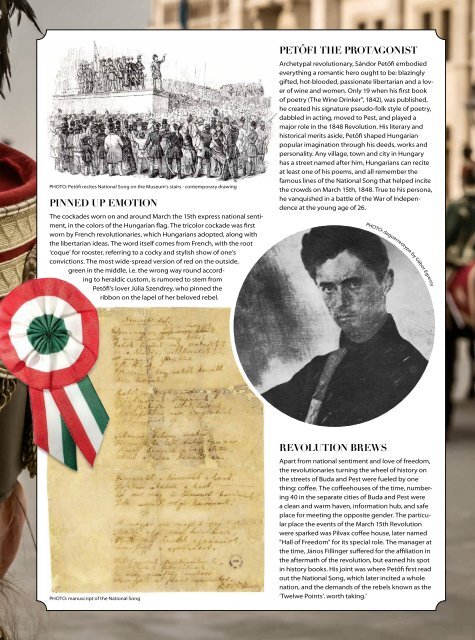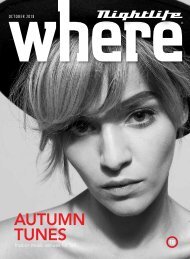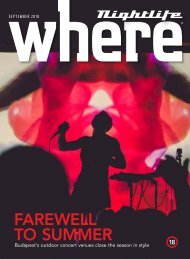WHERE beliv_marcius_2019
Create successful ePaper yourself
Turn your PDF publications into a flip-book with our unique Google optimized e-Paper software.
PHOTO: Petőfi recites National Song on the Museum's stairs - contemporary drawing<br />
PINNED UP EMOTION<br />
The cockades worn on and around March the 15th express national sentiment,<br />
in the colors of the Hungarian flag. The tricolor cockade was first<br />
worn by French revolutionaries, which Hungarians adopted, along with<br />
the libertarian ideas. The word itself comes from French, with the root<br />
‘coque’ for rooster, referring to a cocky and stylish show of one’s<br />
convictions. The most wide-spread version of red on the outside,<br />
green in the middle, i.e. the wrong way round according<br />
to heraldic custom, is rumored to stem from<br />
Petőfi’s lover Júlia Szendrey, who pinned the<br />
ribbon on the lapel of her beloved rebel.<br />
PETŐFI THE PROTAGONIST<br />
Archetypal revolutionary, Sándor Petőfi embodied<br />
everything a romantic hero ought to be: blazingly<br />
gifted, hot-blooded, passionate libertarian and a lover<br />
of wine and women. Only 19 when his first book<br />
of poetry (The Wine Drinker", 1842), was published,<br />
he created his signature pseudo-folk style of poetry,<br />
dabbled in acting, moved to Pest, and played a<br />
major role in the 1848 Revolution. His literary and<br />
historical merits aside, Petőfi shaped Hungarian<br />
popular imagination through his deeds, works and<br />
personality. Any village, town and city in Hungary<br />
has a street named after him, Hungarians can recite<br />
at least one of his poems, and all remember the<br />
famous lines of the National Song that helped incite<br />
the crowds on March 15th, 1848. True to his persona,<br />
he vanquished in a battle of the War of Independence<br />
at the young age of 26.<br />
PHOTO: daguerreotype by Gábor Egressy<br />
PHOTO: manuscript of the National Song<br />
REVOLUTION BREWS<br />
Apart from national sentiment and love of freedom,<br />
the revolutionaries turning the wheel of history on<br />
the streets of Buda and Pest were fueled by one<br />
thing: coffee. The coffeehouses of the time, numbering<br />
40 in the separate cities of Buda and Pest were<br />
a clean and warm haven, information hub, and safe<br />
place for meeting the opposite gender. The particular<br />
place the events of the March 15th Revolution<br />
were sparked was Pilvax coffee house, later named<br />
"Hall of Freedom" for its special role. The manager at<br />
the time, János Fillinger suffered for the affiliation in<br />
the aftermath of the revolution, but earned his spot<br />
in history books. His joint was where Petőfi first read<br />
out the National Song, which later incited a whole<br />
nation, and the demands of the rebels known as the<br />
’Twelwe Points’. worth taking.’<br />
www.wheretraveler.com 9

















